Key takeaways:
- Social listening involves monitoring online conversations to gain insights into customer feelings and needs, transforming passive observation into active engagement.
- Utilizing tools like Hootsuite and Sprout Social helps in gathering and analyzing customer sentiment, revealing trends and areas for improvement.
- Engaging directly with customers and facilitating team discussions on social insights can uncover valuable perspectives and drive meaningful changes.
- Being responsive to customer feedback and adapting strategies based on insights fosters stronger relationships and enhances customer trust.
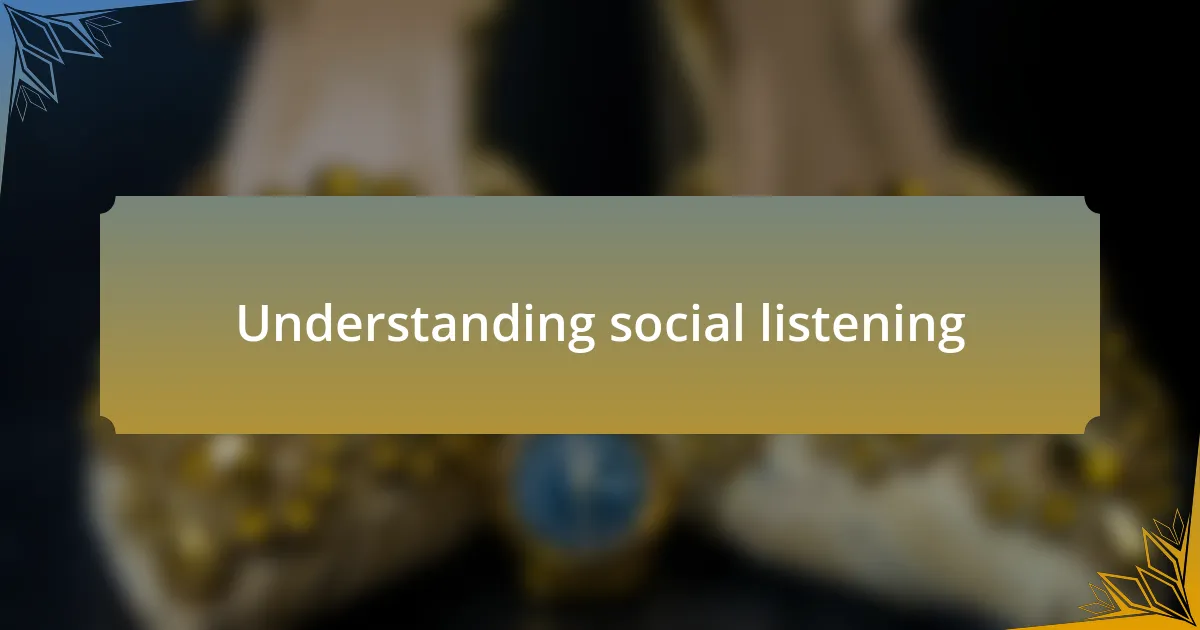
Understanding social listening
Social listening, at its core, is the practice of monitoring digital conversations to understand what people are saying about a brand or topic online. I remember my early days in customer experience when I discovered that simply paying attention to social media mentions could unveil valuable insights. It was eye-opening to realize that customers often share their thoughts and feelings freely, and by tuning into those currents, we can better grasp their needs and expectations.
Have you ever found yourself scrolling through comments on a brand’s post, feeling the pulse of customer sentiment? It’s fascinating how these interactions reveal not just preferences but also deeper emotions. For instance, I once encountered a heartbreaking story from a customer expressing disappointment, which ultimately led us to improve our service. This experience underscored the power of social listening—not just as a tool for gathering data but as a means to connect with customers on an emotional level.
Diving deeper into social listening means recognizing it as more than just a trend; it’s a fundamental shift in how we engage with our audience. In my experience, this involves actively seeking out conversations on platforms beyond the obvious ones, like niche forums or review sites. Navigating these spaces allows us to capture a broader spectrum of feedback, which can illuminate areas for growth and innovation that we might otherwise overlook.

Importance of social listening
Social listening is crucial because it transforms passive observation into active engagement. I vividly recall a moment when a customer voiced their frustration about a product malfunction on social media. Instead of dismissing it, we took the time to respond thoughtfully. This not only diffused a potential PR crisis but also turned that customer into a loyal advocate. Isn’t it interesting how a single interaction can redefine a relationship?
Moreover, understanding the importance of social listening reveals the underlying trends that often escape traditional market research. I once noticed a recurring theme in customer feedback regarding our delivery times. Armed with this insight, we streamlined our logistics, resulting in a measurable uptick in customer satisfaction. This experience taught me that social media isn’t just about trends; it’s about identifying pain points and addressing them directly.
Lastly, social listening isn’t merely about negative feedback; it’s an opportunity to celebrate positive sentiments as well. I feel there’s immense power in acknowledging customer praise publicly. One time, I saw a glowing comment about our service, and I quickly thanked the customer on behalf of the team. This simple act not only strengthened our relationship with that individual but also inspired others to share their positive experiences. How often do we miss these chances to enhance customer loyalty?
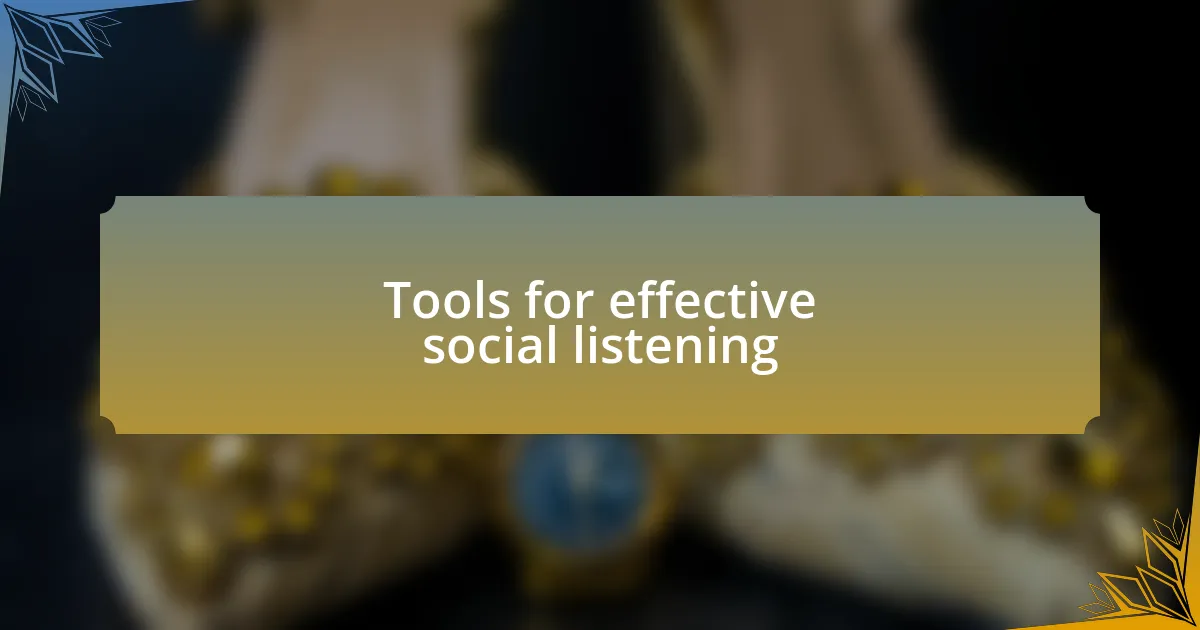
Tools for effective social listening
When it comes to tools for effective social listening, I’ve found that platforms like Hootsuite and Brandwatch are invaluable. These tools provide a comprehensive way to monitor mentions across various social media channels, enabling the identification of key conversations about your brand. I remember the first time I set up alerts on Hootsuite; it felt like having my finger on the pulse of customer sentiment. It really underscores why being proactive is vital in today’s digital landscape.
Another tool that has proven essential in my experience is Sprout Social. Its analytics feature allows me to dive deep into engagement metrics, revealing not just what customers are saying, but how they feel. One particular instance stands out: we discovered a significant drop in engagement after a product launch. By analyzing the data, I pinpointed communication gaps and adjusted our messaging to better align with customer expectations, which revived interest almost instantly. Isn’t it fascinating how numbers can tell a story waiting to be uncovered?
Beyond just functional tools, I also believe in the power of listening to employees who engage with customers directly. Tools like Slack can enhance internal communication, allowing frontline staff to share insights quickly. I recall a situation where a team member flagged a trending issue during a casual chat. That piece of feedback led us to a brainstorming session that ultimately created a new feature customers loved. This highlights that social listening isn’t only about external sources; it’s also about fostering an internal culture of open communication and collaboration. How often do we tap into that potential within our own teams?
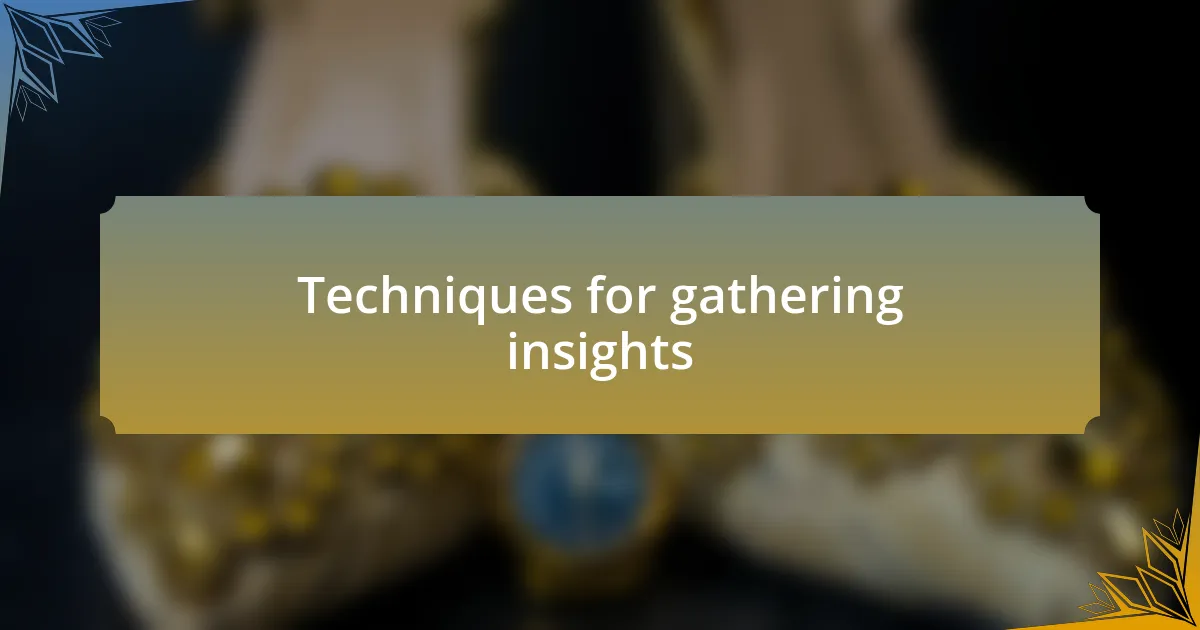
Techniques for gathering insights
Utilizing surveys and polls is one technique I’ve found particularly effective for gathering insights. I often send out short surveys to our customer base after significant changes or launches. For instance, after we revamped our website, I was pleasantly surprised by the vast array of feedback I received within just a few hours. This direct line to our customers’ thoughts not only reveals their feelings but also builds a sense of community, showing they’re valued in the process.
Another equally impactful method has been monitoring online reviews and feedback on platforms like Google and Yelp. I recall reading through reviews shortly after a new service was introduced. One review in particular struck a chord: a customer mentioned how our service had exceeded their expectations in a time of need. That moment made me realize the power of authentic testimonials; they not only validate our efforts but also provide insights into what resonates with our audience. Do we take enough time to really listen to this goldmine of feedback?
Finally, I believe in the importance of engaging in social media discussions. By actively participating in conversations on platforms like Twitter and Facebook, I can gauge the pulse of customer sentiment first-hand. I remember a time when I jumped into a Twitter thread discussing a trending industry topic. The insights I gathered helped steer our messaging during a critical campaign. Isn’t it interesting how simply being present in these discussions can lead to unexpected revelations about our customers?
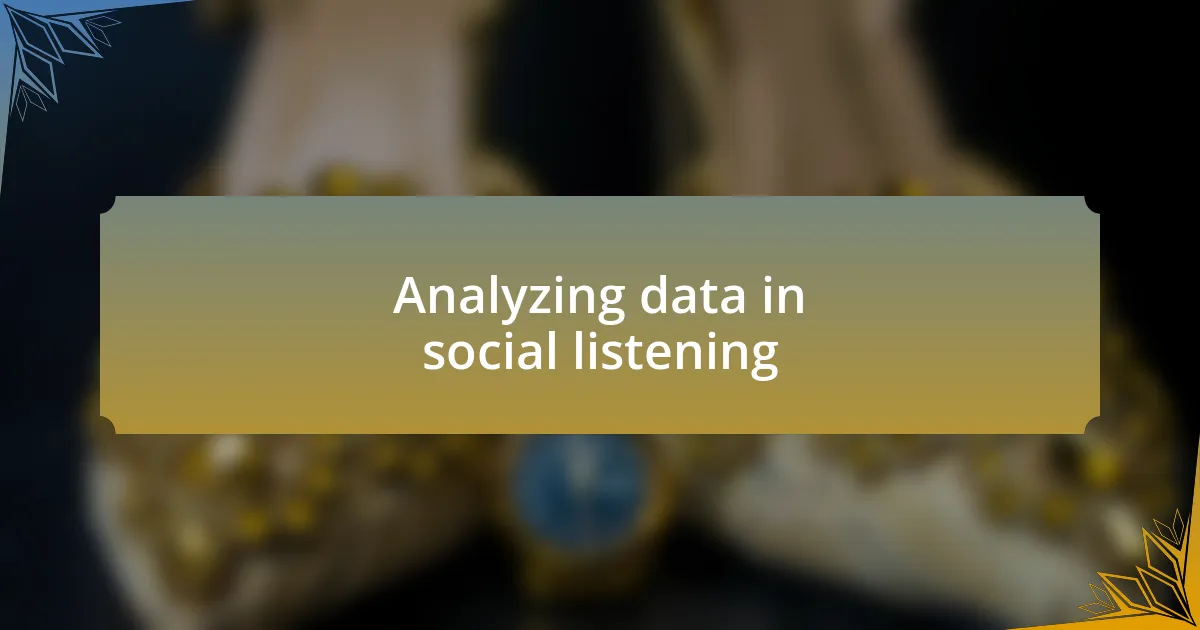
Analyzing data in social listening
Analyzing data in social listening involves diving deep into the conversations that customers are having about your brand across various platforms. I’ve found that simply tracking keywords is not enough; it’s essential to interpret the emotions behind the words. For example, noticing an uptick in mentions of a specific feature can be enlightening, but I always ask, what emotions are accompanying those mentions? This helps me grasp whether the feelings are positive, negative, or even mixed, allowing us to tailor our responses accordingly.
One approach that has proven invaluable in my experience is sentiment analysis. When we launched a new campaign, I took the time to analyze the sentiment surrounding it. I remember feeling a mix of excitement and apprehension as I sifted through the comments. On one hand, there was praise for our creativity; on the other, some concerns about its execution. This dichotomy not only guided our next steps but also reinforced my understanding that positive feedback often comes with constructive criticism. Have we truly embraced this duality in our strategies?
Moreover, I find it crucial to not just analyze the data for trends but to contextualize it within our broader goals. For instance, during a product launch, I closely examined how excitement on social media mirrored the metrics we gathered from our customer service interactions. The day we noticed a spike in engagement online was the same day our customer support team reported an influx of inquiries. It made me realize how interconnected these insights are; it’s all about weaving together narratives from data to understand the complete customer picture. How often do we miss connections like these that could inform our ongoing strategies?
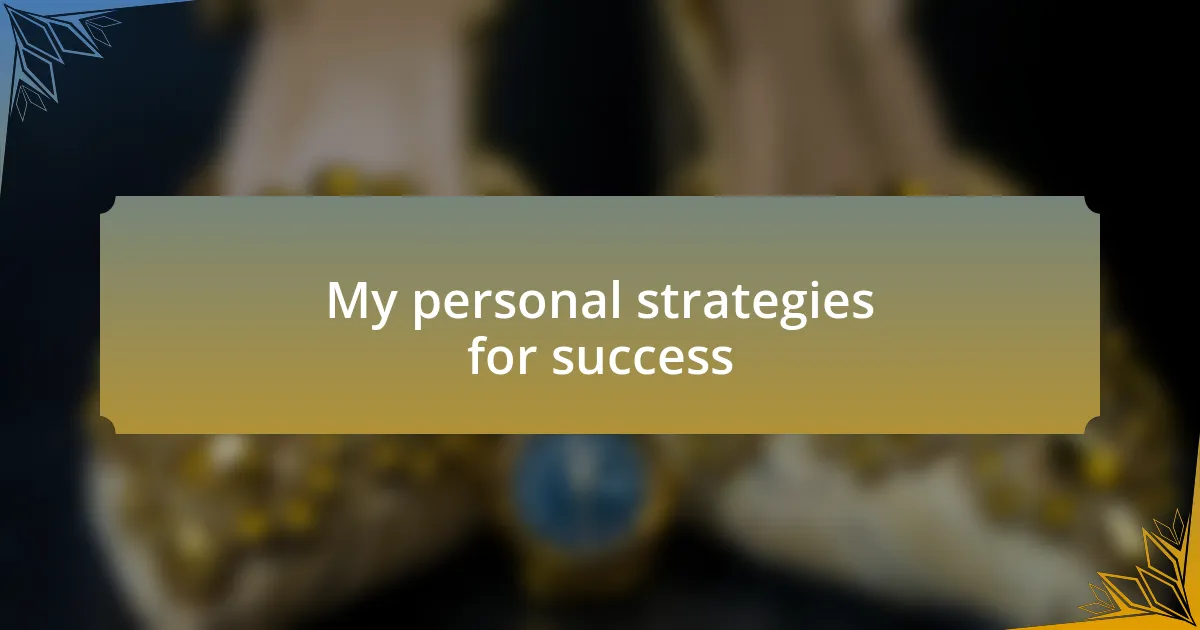
My personal strategies for success
To enhance my social listening efforts, I prioritize engaging directly with customers. I remember a time when a customer tweeted a concern about our product that caught my eye. Instead of just analyzing the tweet, I responded right away, asking for specifics. The conversation that unfolded led us to discover a significant issue that had gone unnoticed, ultimately improving both our product and customer relationship. How many opportunities do we let slip by without seizing that moment of interaction?
Another strategy I employ is setting aside time for regular review sessions with my team. Reflecting on our social listening insights in a collaborative environment makes a world of difference. I recall one particular session where we dissected a range of customer comments about a recent service update. Through open discussion, we unearthed several recurring themes that weren’t initially apparent. It showed me just how valuable diverse perspectives can be in honing our understanding of customer sentiment.
Lastly, I keep a pulse on our competitors, not to mimic their strategies, but to learn from their successes and missteps. I distinctly remember analyzing a competitor’s campaign that generated both praise and backlash, and how it influenced our own planning. Observing how different approaches landed with audiences helped me sharpen our strategies, ensuring we address potential issues before they arise. After all, isn’t it insightful to consider how industry dynamics shape our own customer experiences?
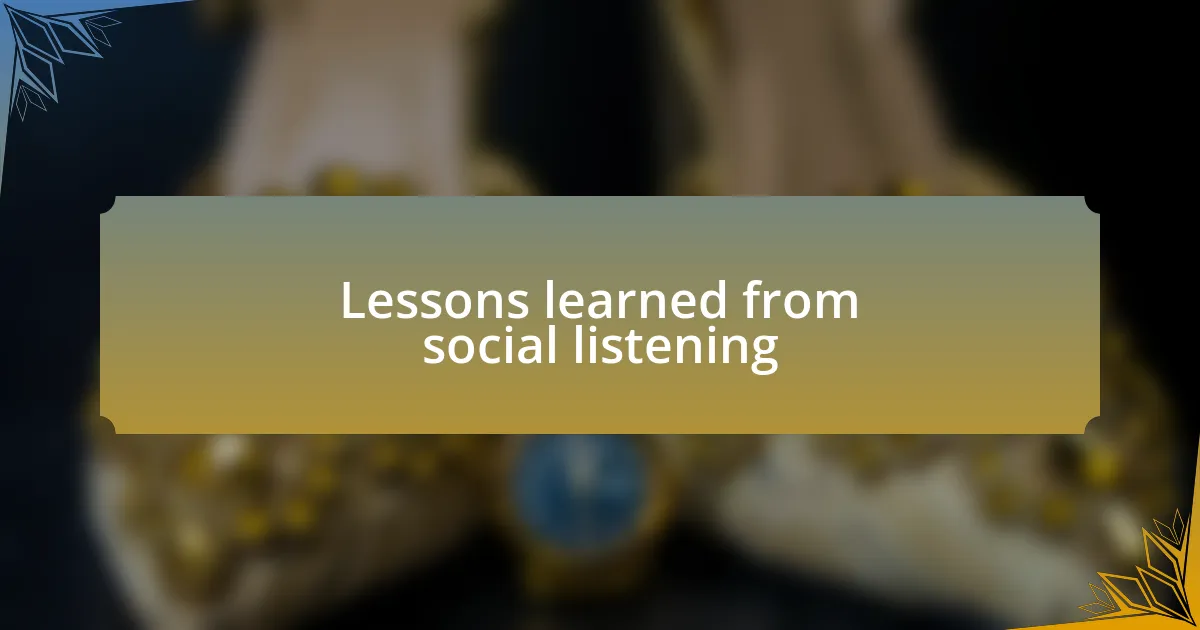
Lessons learned from social listening
Listening to social conversations has taught me that genuine engagement can transform customer feedback into actionable insights. I recall an instance when a customer shared a heartfelt story about how our product helped them through a tough time. That moment resonated with me deeply and reminded me that behind every tweet or comment is a person with a unique experience. Engaging with their stories allows us to connect on a more emotional level, fostering loyalty that surpasses just product satisfaction. Isn’t it incredible how understanding these individual experiences can shape our overall strategy?
Another lesson I’ve learned is that patterns in customer feedback often reveal deeper systemic issues. During a social listening deep dive, I noticed multiple consumers expressing confusion about our return policy. Instead of shoving this feedback aside, I spearheaded a project to simplify our policy and improve communication. That initiative not only reduced confusion but also enhanced customer trust. It made me realize the power of attentive listening; when we stay tuned in, we can proactively resolve issues before they escalate.
Finally, social listening has highlighted the importance of adapting quickly to trends and conversations shaping our industry. I remember monitoring a trending topic that our target audience was buzzing about. Instead of waiting to see how it unfolded, we aligned our messaging to reflect the ongoing discussion, which significantly increased our engagement metrics. This experience illustrated that being responsive and relevant can create authentic connections. How often do we miss the chance to join an important conversation?